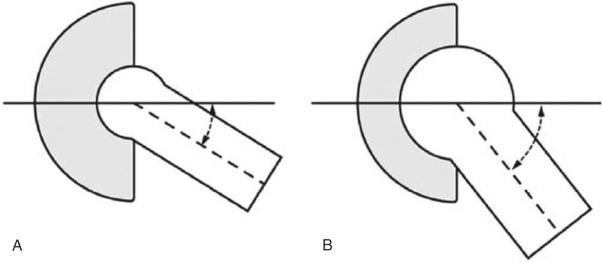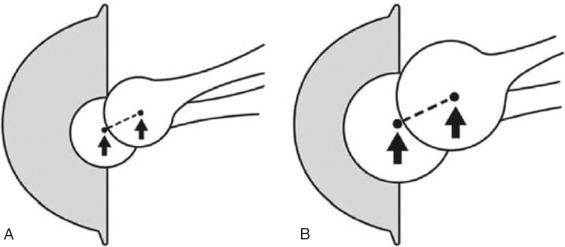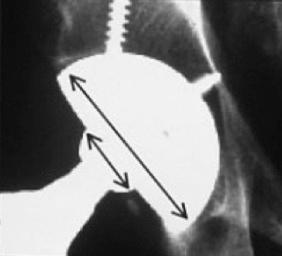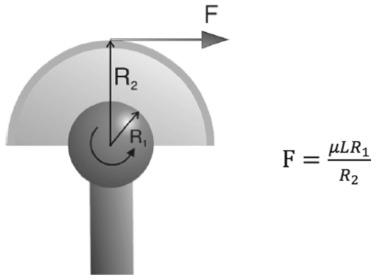Physical Address
304 North Cardinal St.
Dorchester Center, MA 02124
Historically, 22.25-, 26-, 28-, or 32-mm metal femoral heads were used in primary total hip arthroplasty (THA), but innovations in materials now permit head sizes 36 mm or larger.
Stability and wear of primary THA are related to the diameter and material of the femoral head.
Larger-diameter femoral heads are associated with increased joint stability through increases in arc range of motion and excursion distance prior to dislocation.
Fixation of the acetabular component may be related to the size of the femoral head, with increased frictional torque associated with large-diameter heads and certain polyethylene.
Linear wear of highly cross-linked polyethylenes (HXLPE) seems unrelated to femoral head diameter, but larger heads have been reported to have higher volumetric wear.
Mechanically assisted crevice corrosion (“trunnionosis”) at the connection between the modular femoral head and neck may be associated with femoral head size and material.
Cobalt chromium alloy, alumina ceramic composite, or oxidized zirconium femoral heads on HXLPE are the most commonly used bearing surfaces, but each may have unique risks and benefits.
The optimal femoral head size and material remains a controversial issue in primary total hip arthroplasty (THA). In the 1950s, McKee and Watson-Farrar introduced a large-diameter femoral head for primary metal-on-metal THA. In the early 1960s, Charnley introduced a 41.5-mm stainless steel femoral head articulating with a polytetrafluoroethylene (Teflon; DuPont, Wilmington, DE) acetabular component, but noted early catastrophic wear and osteolysis. Considering the high frictional torque associated with a large femoral head was the cause of failure, Charnley later popularized cemented components, consisting of a 22.25-mm stainless steel femoral head articulating with a cemented ultra-high molecular weight polyethylene acetabular component, the “low friction arthroplasty.” Charnley reported a rate of dislocation of less than 1% with this prosthesis, but this was likely related to the routine intraoperative osteotomy and advancement of the greater trochanter and prolonged postoperative bed rest. Other surgeons, however, introduced 26-, 28-, and 32-mm femoral heads because of the problem of dislocation associated with the small femoral head. Femoral heads larger than 32 mm were generally avoided, however, due to concerns of increased wear and osteolysis seen with conventional polyethylene. Consequently, a 28-mm cobalt-chromium (Co-Cr) alloy femoral head was the most commonly used component for over 20 years.
The introduction of alternative bearing surfaces in the late 1990s—including metal-on-metal (MOM), ceramic-on-ceramic, and especially highly cross-linked polyethylenes (HXLPEs)—permitted the use of femoral head sizes greater than 32 mm. Femoral heads measuring 36 mm or larger are routinely available for modern primary THA. According to the National Joint Registry of England, Wales, and Northern Ireland, 36-mm femoral heads accounted for more than 35% of primary THAs in 2011, compared to less than 5% in 2005. It was estimated that 66% of the femoral heads implanted in primary THAs in the United States in 2014 were 36 mm or larger.
There are now a variety of femoral head materials and sizes available for use. The potential benefits and risks associated with these components may be crucial for the long-term success of primary THA. This chapter will discuss the concepts of joint stability, component fixation, wear, and corrosion related to the various types and sizes of femoral head components of modern THA.
Dislocation continues to be a common complication after primary THA, with prevalence ranging from less than 1% to 5.8%, depending on length of follow-up. In the United States Medicare patient population, dislocation is the most frequent cause of revision, followed by aseptic component loosening. While the cause of instability often involves multiple operative and patient-specific factors, the size of the femoral head has been considered a major risk factor for dislocation through alterations in the primary arc range, excursion distance, and impingement-free range of motion (ROM).
Primary arc range is defined as the arc of motion that the femoral head can achieve in the acetabular component prior to prosthesis impingement and is related to the head/neck ratio ( Fig. 73.1 ). An increase in the head/neck ratio with a larger femoral head results in improvements in the primary arc ROM and enhances overall joint stability. Factors that decrease the head/neck ratio—such as a smaller-diameter femoral head, a “skirted” or extra-long modular femoral head, and a constrained liner—diminish the primary arc range and increase the risk of subluxation and dislocation.

The excursion or “jump” distance is defined as the distance that the femoral head must travel after impingement to dislocate and is equal to the radius of the femoral head ( Fig. 73.2 ). Larger femoral heads inherently have a higher excursion distance than smaller heads ( Table 73.1 ). For example, once the femoral component begins to impinge on the acetabular component, a 44-mm head will have to travel twice the distance that a 22-mm head would have to travel prior to dislocation.

| Femoral Head Diameter (mm) | Displacement Prior to Dislocation (mm) |
|---|---|
| 22 | 11 |
| 28 | 14 |
| 32 | 16 |
| 36 | 18 |
| 40 | 20 |
| 44 | 22 |
The postoperative functional ROM achieved by a patient is multifactorial and related to the preoperative ROM, occurrence of heterotopic ossification, component position, and femoral head size. Larger femoral heads should provide a patient with an improved functional ROM. In an experimental and computational simulation, Scifert et al. reported that hip ROM in all directions increased 0.84 ± 0.43 degrees with each 1-mm increase in femoral head diameter. Other in vitro studies reported that the increase in ROM with larger femoral heads plateaus beyond a certain diameter. In a computer simulation study, Cinotti et al. reported that overall ROM increased 5.3 degrees with an increase in the head diameter from 28 to 32 mm but with little further increase when the head size changed from 32 to 38 mm. In a cadaveric study of 6 hips, Bartz et al. reported that an increase in femoral head diameter from 22 to 28 mm resulted in significant improvements in preimpingement ROM, but an increase from 28 to 32 mm yielded no additional benefit. This lack of improvement in ROM with a femoral head diameter greater than 32 mm was presumed to be secondary to bone-to-bone impingement. While a very-large-diameter femoral head may virtually eliminate component-to-component impingement, bone-to-bone impingement may occur when the femoral head exceeds a certain diameter, which could prevent additional improvements in ROM.
There are numerous older clinical studies that compared the risk of early dislocation with 22.25-, 28-, and 32-mm femoral heads in cemented primary THA components, but these studies may not be relevant with modern cementless components. Using the Norwegian Arthroplasty Registry of over 42,900 patients, Byström et al. reported that patients with 28-mm heads were 4 times more likely to require revision for instability than patients with 32-mm heads. Using the Mayo Clinic Joint Replacement Registry, Berry et al. reported that rates of dislocation were significantly lower in hips with 32-mm femoral heads compared to hips with 22- and 28-mm femoral heads, despite the surgical approach, in 21,000 patients over 20 years. In a multicenter randomized controlled trial of 640 patients with modern uncemented components, Howie et al. reported that the rate of dislocation at 1 year with a 36-mm femoral head was significantly lower than a 28-mm femoral head (1.3% vs. 5.4%, P = .01). In a review of 19,623 modern cementless THAs in the Kaiser Permanente Total Joint Replacement Registry between 2001 and 2013, Cafri et al. reported that head sizes less than 32 mm were associated with increased risk of dislocation within 1 year compared to 36 mm for metal (hazard ratio [HR] = 2.99, 95% confidence interval [CI] [1.40–6.39]; P = .005) and ceramic (HR = 15.69, 95% CI [6.07–40.55]; P < .001) heads. To our knowledge, there are no randomized controlled studies comparing the rate of dislocation between a 32- and 36-mm femoral head in modern cementless primary THA.
The benefits of a larger femoral head size on modern bearing surfaces can be minimized by malposition of the components, large acetabular components, and mismatch between femoral head and acetabular component diameters. D'Lima et al., using a 3-dimensional computer model, reported a nonlinear association between the size of the femoral head and the risk of dislocation. Maximum hip ROM was observed with acetabular abduction angles ranging from 35 to 55 degrees and femoral anteversion angles ranging from 0 to 30 degrees. An increase of acetabular component abduction resulted in increased hip flexion, extension, and external rotation. An increase in femoral anteversion resulted in decreased hip flexion and extension but increased abduction and abduction.
Kelley et al., in a 2-part clinical study, reported the association between the outer diameter of an uncemented acetabular component, the femoral head size, and the risk of dislocation. In a retrospective review of 308 primary THAs with a 28-mm modular metal femoral head and uncemented acetabular components (outer diameters ranging from 46 to 70 mm), the risk of dislocation significantly increased in patients with an acetabular component outer diameter greater than or equal to 58 mm ( P = .039). In a prospective, randomized trial of 61 patients who had primary THA with a 22- or 28-mm metal femoral head and an uncemented acetabular component, Kelly et al. reported a significantly increased risk of dislocation of the 22-mm femoral heads in acetabular components larger than 56 mm. Every patient with a 22-mm femoral head in an acetabular component greater than 56 mm had at least 1 dislocation, but no dislocation occurred in patients with a 22-mm head in an acetabular component less than 54 mm. No dislocations occurred in patients with a 28-mm femoral head in any diameter acetabular component. The authors proposed a new method for selection of femoral head size in primary THA based on the outer diameter of the acetabular component implanted, which they call the “graduated femoral head size system” ( Table 73.2 , Fig. 73.3 ).
| Acetabular Outer Diameter (mm) | Femoral Head Diameter (mm) |
|---|---|
| ≤ 50 | 22 |
| 52–54 | 26 |
| 56–60 | 28 |
| ≥ 62 | 32 |

In a prospective cohort study of 2734 primary THAs with a 28-mm ceramic head on a polyethylene liner or 28-mm metal head on a metal acetabular component, Peters et al. reported that there was a significantly increased risk of dislocation at 1 year in hips with an acetabular component greater than or equal to 56 mm in outer diameter compared to hips with smaller components (4.3% vs. 1.3%; P < .01). After adjusting for age, sex, body mass index, height, and diagnosis, the hips with acetabular components greater than or equal to 56 mm had a 2.4 times (95% CI 1.2–4.9) greater risk of dislocation in the first postoperative year than hips with smaller acetabular components.
Fixation of the acetabular component may be related to the size of the femoral head through the concept of frictional torque. Frictional torque is defined as the resultant rotational force that occurs when 2 objects that are in contact move. The frictional force at the bone–acetabular component interface can be calculated according to the equation in Fig. 73.4 . An increase in femoral head diameter results in a proportionate increase in the ratio of the inner and outer diameters of the cup. According to the equation, the frictional force generated at the bone–acetabular component interface increases with a larger-diameter femoral head and decreases with a larger-outer-diameter acetabular component. Larger femoral heads generate more frictional force that can theoretically affect the bone-cement interface or the bone-component at the acetabulum and increase the risk of aseptic loosening.

Large cohort studies reported conflicting results of the influence of frictional torque on aseptic loosening of cemented polyethylene acetabular components. In a study of 6100 THA revisions, Morrey and Ilstrup reported that aseptic loosening of the cemented acetabular component was significantly higher in hips with a 32-mm femoral head compared to hips with 22- or 28-mm heads. Frankel et al. reported an over tenfold increased risk of aseptic loosening of hips with 32-mm heads compared to 22-mm heads. The increased frictional torque generated by the hips with the 32-mm femoral heads may be related to loosening of a cemented acetabular component. However, other studies suggested that the frictional torque produced with these femoral heads may not be significant enough to cause loosening of acetabular components. The higher rate of loosening seen with 32-mm femoral heads in hips with cemented components was more likely related to periprosthetic osteolysis from volumetric wear of the conventional polyethylene rather than the frictional torque.
Two recent in vitro studies have investigated the frictional forces associated with modern cementless THA components. Meneghini et al. performed a laboratory study of the frictional torque generated by Co-Cr alloy and ceramic femoral heads articulating with either HXLPE or vitamin E–infused liners. The authors reported that large-diameter (≥ 36 mm) Co-Cr alloy femoral heads articulating with vitamin E–infused liners generated significantly more frictional torque than smaller (≤ 32 mm) ceramic heads and HXLPE. In a similar study using metal femoral heads ranging from 22 to 40 mm, Burroughs et al. reported that greater frictional torque was generated with larger-diameter heads articulating on HXLPE for several different loading patterns.
There are 2 clinical studies of the fixation of modern cementless acetabular components with large-diameter femoral heads, a surrogate for increased frictional torque. Sachde and Maru reported on 28 primary THAs with a 36-mm Co-Cr head and HXLPE. At a minimum follow-up of 4 years, there was no dislocation, failure due to aseptic loosening, or radiographic periprosthetic osteolysis in any hip. Lachiewicz and Soileau reported the results of 112 THAs in patients considered at high risk for dislocation with 36- or 40-mm Co-Cr alloy head and HXLPE. At a mean follow-up of 6.5 years, no hip was revised for aseptic loosening, but there was at least 1 dislocation in 4% of these “high-risk” hips.
Become a Clinical Tree membership for Full access and enjoy Unlimited articles
If you are a member. Log in here